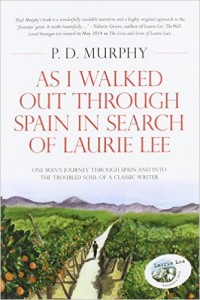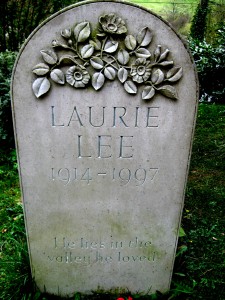Book Review: Personal Histories of Place
P. D. Murphy, As I Walked Out Through Spain in Search of Laurie Lee (Bristol: Silverwood Books, 2014).
P.D. Murphy’s desire to follow in the footsteps of Laurie Lee sends him on a personal journey through the history, culture, and geography of Spain—and forces him to explore his own personal history and identity.
Some literary and cultural critics have suggested in recent years that, for the majority of Spaniards, the brutal Civil War (1936-39) is the most significant event in the history of their country, an event which must be confronted and revisited in order to understand present-day Spain. While celebrated Spanish authors like Javier Cercas, Isaac Rosa, and Lorenzo Silva have penned narratives that address the complexities of the nation’s collective and personal histories, British author P. D. Murphy’s novel As I Walked Out Though Spain in Search of Laurie Lee reveals the perspective of a non-Spaniard—an outsider, so-to-speak—who nevertheless has deep personal connections to Spain. In this novel, Murphy’s desire to follow in the footsteps of his literary hero, English writer Laurie Lee (1914-1997), not only sends him on a personal journey through the history, culture, and geography of Spain, but also forces him to explore his own personal history and identity.
According to Murphy, his novel is a story of two journeys, on two levels: “Laurie Lee’s through Spain in 1935 and how it profoundly shaped the way his life unfolded; [and] my journey following in his footsteps across Spain in 2012 and how it has given me a second chance in life.” Indeed, Murphy is the first person to retrace the path across Spain blazed by Lee just prior to the onset of the Spanish Civil War. While Lee’s walk from northern Galicia to southern Andalusia would form the basis for one his most successful novels, As I Walked Out One Midsummer Morning (1969)—a coming of age tale of a young man’s journey across an unfamiliar country that would enchant and inspire him—Murphy’s modern-day route culminates in the publication of this curious narrative that blurs the boundaries between fiction and non-fiction; among biography, hagiography, and autobiography; and between past and present.
Murphy is the first person to retrace the path across Spain blazed by Lee just prior to the onset of the Spanish Civil War.
Though Murphy’s path is recorded chronologically, he mixes past and present interspersing his account with dated entries from Lee’s account. This technique provides a rich narrative for Murphy’s recreation of Lee’s experiences for modern-day readers. Murphy is often prompted by his arriving at the same place as Lee had, observing the same buildings Lee detailed, or breathing in the same colored landscape so poetically captured by his literary idol.
By following in the path of his own literary hero, Murphy embarks on a journey that will not only connect him to Lee and his history, but also afford him clarity and acceptance with regards to his own personal history, identity, and experiences of loss. He confronts his rocky relationship with his father and learns to accept the dissolution of his marriage and his present relationship with his daughter. Yet to achieve this solace Murphy, like Lee before him, must set out from his familiar surroundings, navigate the unexpected roadblocks or detours of the foreign land through which he travels, and finally return home transformed, where he will reintegrate into the society he had left behind.
Murphy, like Lee before him, must set out from his familiar surroundings, navigate the unexpected roadblocks or detours of the foreign land through which he travels, and finally return home transformed.
I found the sense of place to be the strongest aspect of Murphy’s book. A map of the similar routes both Lee and Murphy took across Spain, in 1935 and 2012 respectively, is included among the novel’s foreword and introduction. On this single map the reader can compare the two pilgrimages and use the visual as a point of reference. A perhaps self-conscious observation confirming the pertinence of place appears in Murphy’s musings during the second half of his narrative: “The essence of a place is made up of the people who live there and their stories.” Surely reflective of Murphy’s own philosophy, this line is fitting for a journey that includes a solemn visit to the Valley of the Fallen, Toledo’s Alcazar that houses the National Museum of the Army, and a stop in a small local bar in Cádiz that resulted in an intimate conversation with a young gypsy musician.
While place is crucial to capturing the spirit of the Spanish nation (its duende, as Murphy accurately refers to it) and the protean Spanish countryside that both writers so dearly love(d), the role of History is equally important. For a nation whose transition from dictatorship to democracy was marked by a philosophy of “forgetting the past” in order to look towards the future, the notion of recovering and acknowledging a traumatic history is a heavy cross to bear. Murphy’s book captures the complexities of Spanish attitudes towards the nation’s history by recounting interactions with Spaniards. Late in the book a Spaniard and his American-born wife reveal their opposing views regarding the exhumation of bodies from sites purportedly containing mass graves. His is representative of the conservative viewpoint: the war is over and Spaniards should attempt to live in peace by not meddling with the past or disturbing the dead. His wife is of the opposite opinion, generally supported by those with Republican ties or members of younger generations of the international community: the dead deserve justice, respect, and honorable burials, just as the victors who supported the Francoist cause received upon the war’s end. Murphy refrains from engaging passionately in such discussions, though a careful reader will notice that his views most closely align with those in favor of recognizing Spain’s past sins.
As I Walked Out Through Spain in Search of Laurie Lee is an enjoyable and informative read for anyone interested in the life or writings of Laurie Lee, the ghosts of the Spanish Civil War that still haunt Spain’s psyche, or the geography, history, art, and people of Spain.
Rebecca Bender is an Assistant Professor of Spanish Language and Literature at Kansas State University. She specializes in 19th-21st century Spanish Peninsular literature and culture and focuses on issues of gender and sexuality, motherhood and feminism, and urban and cultural studies. You can read about her teaching and research projects on her blog, http://rebeccambender.wordpress.com.















[…] different than what I typically do as a Spanish language and literature professor – a book review of a recently published English language book: As I Walked Out Through Spain in Search of Laurie […]